Student Tenants Raise Concerns about the Coronado Page 5
“The Culture:” A Resounding Tribute to Hip-Hop and its Artistic Ephemera Page 7
Graduate Students bound for SLU
Denied Entry, Barred for Five Years
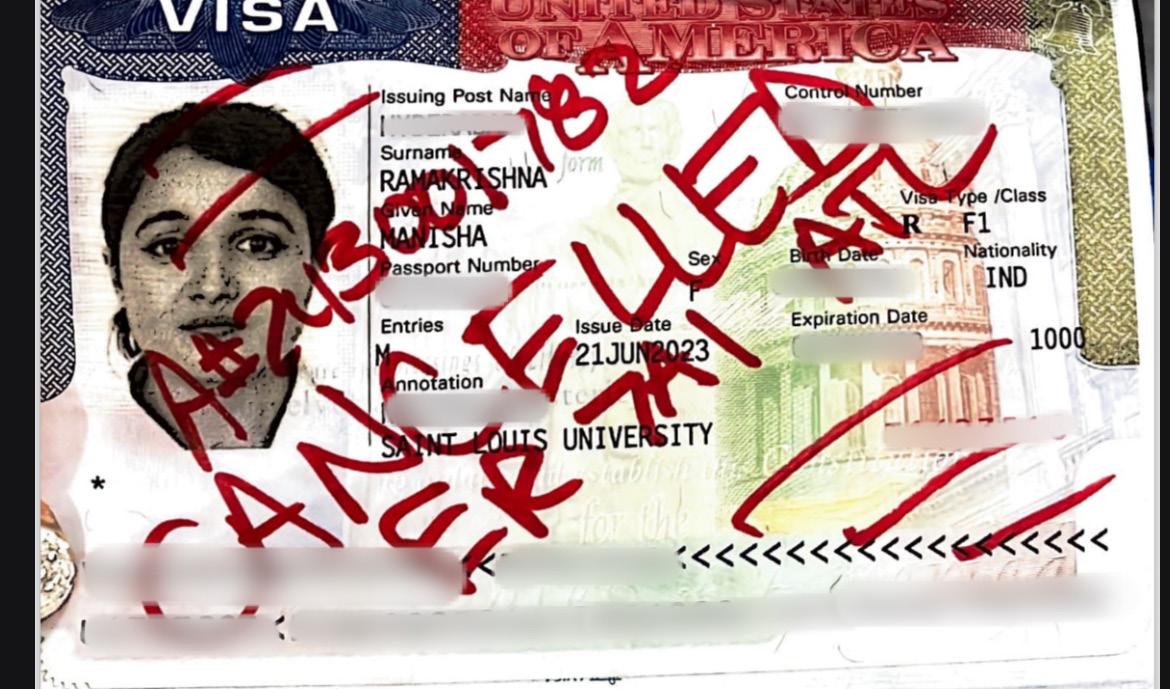
Full Story on Page 2 and 3
2023
(Photo Courtesy of Sarah Conroy)
Vol. CII No. 1 SepT.
Graduate Students bound for SLU Denied Entry, Barred for Five Years
LAUREN HUTCHENS News Editor
Twenty-one graduate students from India –approximately 15 meant to attend Saint Louis University – were denied entry after being stopped by U.S. Immigration and Customs Enforcement for visa-related issues despite completing all of the regular visa formalities. The students are now barred from traveling outside the country for five years, their visas are canceled, they have lost nearly $10,000 and experienced what they say is insurmountable trauma.
Two students admitted to SLU, Manisha Ramakrishna and Balaji Srinivas, a couple from Bangalore, India, claimed they traveled together for 28 hours before being held at the HartsfieldJackson Atlanta International Airport along with the 19 other students, all bound for schools in Missouri and South Dakota.
After a long interrogation process, the couple was sent back to India with a myriad of loose ends. Without documents to appeal their barrement and visa cancellations, they are left with few options.
The couple, now jobless, say that they put their house up for a mortgage and sold their motorbike in order to attend SLU. Among other complications and poor conditions, they were threatened by their interviewers, went without food and water for 26 hours and had their luggage delayed by five or six days upon their return to India.
According to Rebecca Bahan, director of SLU’s Office of International Services, only eight students have reached out to them so far about the situation at hand, but they are unsure of how many were bound for SLU. Unless the students reach out to them directly, they said that they cannot know how many students were SLU bound.
During the couple’s separate interviews, they reported that the immigration officers accused the students of coming to the U.S. illegally under the guise of being students, despite their abundance of documents and proof.

The Arrival
When they first landed in Atlanta, the couple’s first stop was the immigration security check, where their passports were reviewed and they were asked standard arrival questions. Afterward, they were abruptly escorted to the immigration office
by police, where they waited for their names to be called.
After about half an hour, Ramakrishna was called to the office.
“The first thing they asked me was, what is the purpose of this [travel]?” said Ramakrishna.
She explained that she was going to pursue her master’s in mechanical engineering at SLU. She was then asked if she had paid her tuition fees. When she answered with an honest no, the interrogation continued.
“I said no, I have not paid tuition fees,” said Ramakrishna. “The university itself told us in the pre-departure/arrival to come here and pay the fees.”
said Ramakrishna. “Even though we had the entire proof… like our admit letter, our I-20’s, we had even bought a house to scale up for accommodation and showed the lease agreement stating that we will be staying here and paying money for it.”
Still, the officer continued to insist she and the other students were coming to illegally work.
Shortly after, Srinivas was called into the office and asked the same questions.
Srinivas also talked about the scholarship he had received of $5,500 and an on-campus job paying $1,000. He shared his dreams of becoming a pilot and how SLU has a good aviation program.
“He’s like, ‘So you’re telling me that St. Louis is the only university in the entire universe which offers this service?’” said Srinivas. He continued to explain that no, he had applied to other schools as well, but this was his top choice.
This was when the officer asked for his phone.
“I was just shocked at this moment. Like a phone, why would he ask for my phone?” said Srinivas.
He was asked to unlock the phone and login to his WhatsApp, Instagram and other communication apps. The officer told him that he must only communicate the truth, and any lies would be used against him.
Srinivas was handed a slip of paper stating officers were permitted to check his phone, laptop and any documents they have – and that they have to comply.
Tuition fees are often paid a few weeks after the start of the school term, which is why the couple found this line of questioning odd. Srinivas said he had even emailed SLU the day before their flight wanting to pay the fees early, but was told to wait.
According to Bahan, “1,200 students who have made it in, or 1,000 plus, and none of them paid their tuition [student fees] before coming here.”
Ramakrishna even showed the officers her loan disbursement of around $16,000.
The officer did not believe her. He questioned whether she was truly going to St. Louis as a student or to illegally work. They examined her I-20 form, which proves legal enrollment in a program of study in the U.S., and they continued to ask her more questions about why she chose SLU.
As she continued to answer his questions, officers accused her of lying. Finally, she was asked to return to the waiting room.
“After the entire conversation they had told us ‘you people come here to just work, not study’,”
Afterward, he was asked to wait in a different room as they searched his phone.
He said that inside this room he could see out into the original waiting room but they could not see into his room. The same things were happening to other students who were there too – they were called in, sent out and had their phones taken away as well, Srinivas said.
After waiting for about half an hour to an hour, he was called back in.
“While sitting there,” said Srinivas, “He was staring at me. Like whenever I would look at him randomly he was always staring at me. You know?
Like these big intimidating stares.”
Srinivas said he felt hope for a moment, despite the intimidation, as he had noticed other students getting their passports handed back to them with a white piece of paper.
“He puts a sheet of paper in front of me, which states that they feel I am not a legitimate student trying to enter the U.S. and that they feel the
News 02
(Photo courtesy of Manisha Ramakrishna)
the documents I have are not legal proof,” he said. The Formal Interrogation
He then faced an interrogation interview. “When I saw that, I was fully and completely shocked, like I’m literally not able to feel anything in my body. I’m like what? Is this even real?” said Srinivas after seeing that he may be barred for five years.
something different happened – they ruined her bachelor’s degree certificate.
She said that the officer was curious to see what the certificate looked like in her country.. Once he gave it back to her, upon request, it was folded in half. This can ruin the credibility of the document.
Later in the interview, the officer asked for her I-20, again.
“I told him I already gave him my I-20,” said Ramakrishna. “He said, ‘I lost it, give me another one’, so that’s how careless they were.”
Luckily, she came prepared and had another photo copy in her file, but the officer lost the signed original she had.
She said the officer also questioned why she had a LinkedIn account.
“Then I requested to him to please reduce it, like I begged them, because it was the last hope I had to change their mindset.”
The officers told him to save his energy and not waste their time. He was then asked to sign off on three statements.
The statements: one declaring he spoke the truth, the second to admit he broke the immigration law and the last was an agreement to a five-year ban.
According to Srinivas, the officer then said, “I should give you a lifetime ban for being coached for an interview. Be happy that I’m not giving you a lifetime ban.”
He was then given five seconds to sign, and if he didn’t, the officer would give him a lifetime ban.
LAUREN HUTCHENS News Editor
When he asked what was happening, the officer told him that he was the one asking questions, not Srinivas.
Srinivas was asked to raise his right hand and repeat, “Whatever I speak shall be the truth, and only be the truth. I shall not lie with any sort of forms.”
In addition to questions about his personal life, the officer then began to ask about a consultancy group chat they have on their WhatsApp called Educates IDP. IDP is an education consultancy group in India that guides students with their studies abroad, including admission and visa process.

The officer began to ask about the group chat, specifically about a document shared in the chat of possible questions that could be asked during a visa interview. Srinivas explained to The University News that he wanted to be well-prepared.
“And then he’s like, ‘Do you know it’s against immigration law to be coached for any interviews?’” said Srinivas. Except, the questions provided by IDP were available on many other platforms such as Google, Quora, YouTube or articles published by students sharing their experiences. Bahan confirmed they provide similar questions for their international students as well before they come.
They began to question him again as to why he hadn’t paid the university fees.
He told the officer that he paid a $200 installment deposit, but the officer stated that he could not accept this.
Then the officer asked him to leave the room, but when Srinivas pleaded to talk with them more, they began to threaten him with force or a citation.
The couple believes that the officers did not find their interview and documents satisfactory enough.
Ramakrishna pulled out a large file of documents during a virtual interview. “We have this entire file,” she said. “All of these are documents which we had carried to the U.S., though he didn’t even care to check one of these documents and he stated that we are not just students.”
After he returned to the waiting room, they waited for about four or five hours more before Ramakrishna was called back into the office.
Ramakrishna stated her experience was similar. She had to raise her right hand and pledge to not lie. Her questions were the same as Srinivas, but
“I was literally surprised, why was he linking my LinkedIn account to my immigration?” said Ramakrishna.
Before sending her back to the waiting room, Ramakrishna asked if he planned on sending them back to India – he replied yes.
She asked the officer to inform her parents, since he had confiscated her phone. Ramakrishna said it had been a long time since she had contacted her parents, and felt that her parents should know what was happening. She even asked for a single phone call with them, to which the officer replied, ‘no’.
She said the officer told her he would message her mom for her on WhatsApp, but she later found that he never did.
She went back to sit with Srinivas, and they waited for about three hours before being called again. This time, with even worse news – their visas had been canceled and they were barred from the country for five years.
“We were literally so shocked. We started sobbing so badly,” said Ramakrishna. “It was, I guess, a nightmare for us.”
After they heard the news, they went back to the waiting room. Later, Ramakrishna was called back alone.
Her body and belongings were searched before being moved to a small cubicle cell where she would be held with one other roommate, still without a phone.
In the cell, there was an open toilet with no handle to flush. If she wanted to flush, she would have to ask a guard from the outside to do so for her. Above the toilet was a camera as well, she said.
“We had to sleep on the floor with a very small thin mattress, like a baby-sized mattress, and they had given a very thin aluminum foil type like paperthin, to cover us in the cold,” said Ramakrishna.
With minimal resources, she explained they had no access to food or water until much later.
“You are not provided with any food or water, or any kind of basic human needs,” said Ramakrishna. Later on, Srinivas was the last to be called back to the office. He noted that the time at this point was about 3:30 a.m.
The officers took his biometrics and DNA with a swab of his cheek.
When the officers explained the situation to Srinivas, he pleaded with them to make a change.
“He forced me to sign it basically,” said Srinivas. “We didn’t want to sign. We only wanted to sign for the first one.”
Once he had signed, the officer led him down a narrow hallway where he could see all the cells. That is when he saw Manisha’s bag, and realized she wasn’t sent on a flight back to India right away.
He was taken to a room where eight men were. Before he was allowed into the room, the officer frisked his body and removed some laces, jewelry and anything potentially sharp.
The men in the room were all eating food when he entered the room. He asked the officer for food, and this was the first time he had eaten or drank anything in about 26 hours.
In the room, there were only five beds, a table, chair and a sofa.
“So I had no other option but to sleep on the cold floor and I had to cover myself with like a manufactured or thin aluminum foil. It is as thin as a gift wrapping paper that when I rotated it with my hand or just if I poke it there will be a hole in it.”
For Ramakrishna, after she had been in her cell for many hours, she reached out to one of the officers outside the cell. She asked the officer if she could speak to their senior officer. Around 1 a.m. during their shift change, the senior officer followed up and came to her cell.
“I literally went on my knees, like I kneeled down in front of him, saying ‘could you please rethink this case’,” said Ramakrishna. “Because it is literally our dream.
The officer told her to get an immigration lawyer to challenge the barment in court. He also said that he would re-check their papers the following day before he signed them, but the following day they heard no updates on their case.
03 news
READ MORE...
News 04 Student Political Groups Gear Up for 2024 Election
The run-up to the 2024 presidential election is well underway, and SLU political organizations are busy preparing themselves for an anticipated tumultuous election cycle.
Halfway through the first GOP debate on Aug. 23, moderators Brett Baier and Martha MacCallum, both long-standing Fox News pundits, invited Alexander Diaz, a student at Catholic
University in Washington DC.
Diaz asked the candidates how they plan to calm fears that the Republican Party does not care about the threat of climate change and was, in quick succession, rephrased by the moderators and almost unilaterally ignored and avoided by the candidates.
Vivek Ramaswamy, a right-wing upstart who jettisoned his closest horses (Doug Burgum and Tim Scott) with a flurry of jabs and sentimentloaded statements during the debate, did answer, however, and provided an outright refusal of the merit of these fears. This almost certainly constituted an appeal to the larger Republican base, but it raises an important question for politically-minded college students on both sides of the aisle.
What role will students play in the 2024 elections?
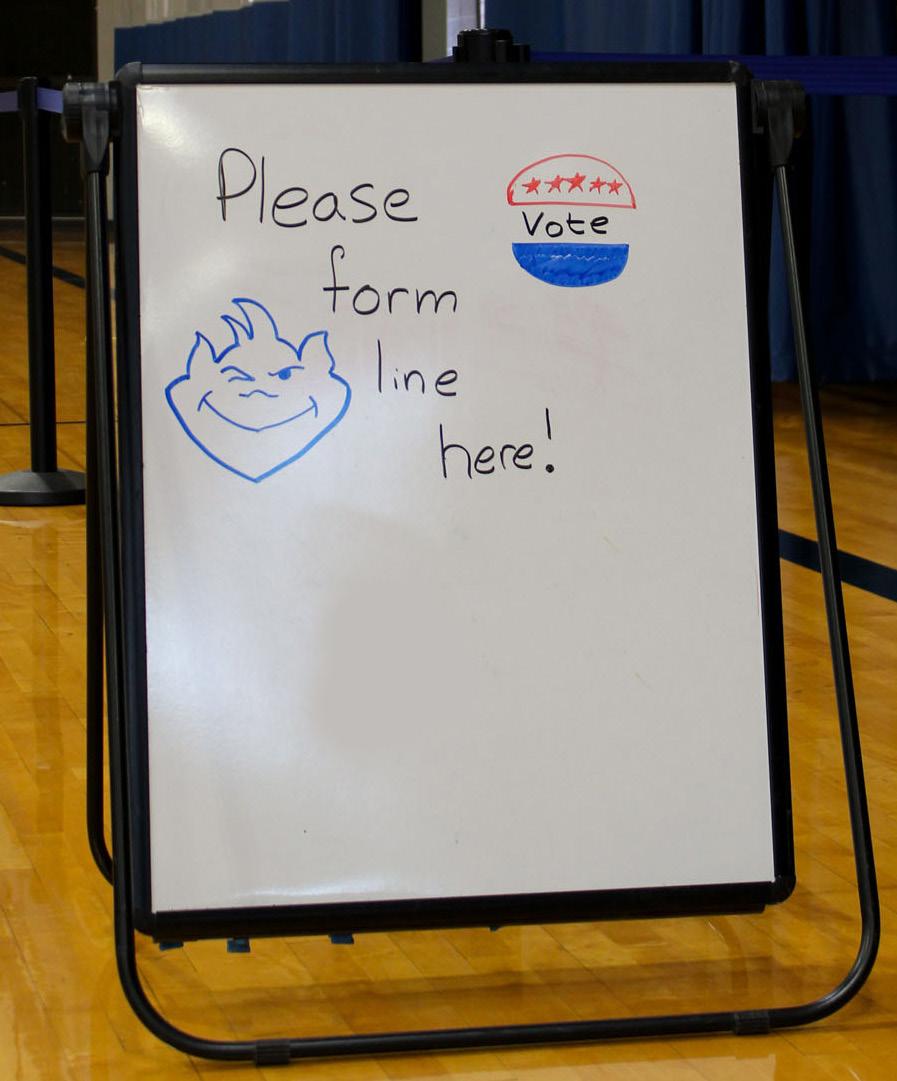
While this singular question may not provide any real insight into the campaign strategies of these candidates, its significance lies in the fact that college students and recent graduates possess major potential for vote-activation.
According to the Washington Post, college students voted at record rates in the 2020 election. Yet, this time around, Democrats are struggling to rally excitement around an incumbent nicknamed Sleepy, and Republicans have entrenched themselves in increasingly unpopular issues, especially among the younger demographic.
Alexandra Leung, the President of the SLU College Republicans, was in attendance at the GOP debate in Milwaukee. She was impressed by the rhetoric of candidates such as Ramaswamy and Haley, but she feels as though many of the primary candidates are currently lacking a strategy for engaging young voters.
“The Republican party, they have to try to connect to us [students] more, because there’s a large gap… While the Democrats do a great job at dominating social media platforms and relating to younger audiences, the Republican Party does not at all,” Leung saidWhile it may seem that there is little ground to be gained for Republicans in the college-aged demographic, the recent
GRANT BELLCHAMBER Staff Writer
“Monitoring the Future” study, a survey on the political alignment of young people conducted since the 70s, found that 12th grade boys are now almost twice as likely to identify themselves as conservative-leaning.
Furthermore, the SLU College Republicans’ membership doubled with the induction of the Class of 2027, Leung said. Although she was initially surprised by the turnout, she began asking what had brought them into the organization.
“What they told me is that they came to St. Louis University looking for a Catholic, Jesuit education, and a lot of conservative Republican values follow… Roman Catholic values.”
On the other hand, the SLU College Democrats briefly went defunct during the last academic year. While Leung attributes this increase to an alignment of interest with incoming students from Catholic high schools, Charles Preiss, Vice President of the College Democrats, explains it differently.
As a multi-year observer of the two organizations, Priess has seen sharp decreases in engagement through the pandemic and believes the disparity between the organizations’ rebounding periods comes down to a matter of function.
“The College Republicans do better than us because they primarily function as a social club for conservatives on campus to talk about politics without being ostracized,” Preiss said. “So they just sort of provide that outlet”
Whatever the underlying reason is, the tides of direct partisan involvement on campus have been shifting, and, with the looming election, these phenomena could possibly serve as indicators of a larger shift in the politics of the college-aged demographic.
Both organizations have events in the works to increase membership and voter engagement.
Gavin Bena, Secretary of the College Democrats, has been actively communicating with politicians for potential events. He described the College Democrats’ focus on political action.
“There’s a signature gathering for abortion [policies] going around right now. The main way any sort of progressive policy gets passed through
Missouri… it’s not through the legislature. So [we’re] just supporting the party in its efforts to stop the extreme rightward tilt in Missouri that’s been happening for the past decade.”
Alexandra Leung, on the College Republicans’ future plans, said, “Coming up, we have watch parties for the election where we’re going to watch the debate, and then talk about it afterwards. And then during our meetings, we also talk about… presidential candidates, what we think of them, how they’re doing so far, [etc.]”
Additionally, The College Democrats have plans to canvas possible swing districts within St. Louis, with a focus on West County, while the College Republicans plan to continue their weekly meetings with a focus on discussing the happenings of the primary.
Preiss, when prompted to envision an ideal SLU political ecosystem, said he hopes for more productive political conversations.
“I want more dialogue between the College Dems and Republicans… I just want more discussion between us that’s not vitriol,” Priess said.
(Andrea Porter / The University News)
news 05
MARIYA YASINOVSKA Copy Editor
The Coronado Place and Towers website claims to be “SLU ‘s best source for attractive apartment homes” but current student residents have a different story to tell, as does the inside of the building.
The Coronado is one of the cheapest and closest housing options near Saint Louis University’s campus. According to current and former residents, the building has serious safety and sanitation concerns.
The University News spoke to six students residing in the Coronado who relayed their poor living conditions. The students’ names are not identified due to their ongoing issues with Coronado management and staff. The University News also spoke to three former residents who all had serious complaints about their time renting.
“Living here in the summer felt like literal hell,” a current SLU tenant said about the Coronado’s unreliable AC.
From the outside, the Coronado looks grand, with tall columns and intricate designs. The building used to be a hotel, and the exterior looks incredibly impressive. However, the inside tells a different story.
Trash and odor problems
The building residents have had to deal with a slew of maintenance and safety-related issues in recent years.
Coronado’s trash disposal system requires residents to leave their waste in the hallways to be picked up. This has led to a heavy trash smell lingering in the hallways.
SLU junior Sarah Fatzinger, 20, lived in the Coronado during her sophomore year, from August 2022 to July 2023. During this time, she experienced various issues with management related to the trash smell, mold and heating and cooling that were left unresolved.
“There would constantly be trash spilled all up and down the hallways,” Fatzinger said.“They never cleaned the hallways or entryways, so the floors were disgusting and if people spilled anything, it would be there for weeks.”
The carpets are filled with mysterious stains, and sometimes trash is left in the hallways for days at a time, causing not only a foul stench but insect infestations. A current tenant, who requested to stay anonymous, said that over the summer she saw a trash bag containing maggots sitting in her hallway. Other residents mentioned fruit fly infestations, roaches and ant problems.
Student Tenants Raise Concerns about the CoronadoW
Unreliable heating and AC
The Coronado website, as well as Coronado’s leasing agreements, also promise 24-hour maintenance, central air conditioning, and free cable and Wi-Fi. Both the Wi-Fi and air conditioning have been reported to disappear randomly, with no warning, no guarantee of how long it will be missing and no updates from the management.
Kaitlyn Barefield, 21, attended SLU and lived in Coronado Place and Towers from August 2022 to July 2023. She said she experienced many air conditioning issues, from the day she moved into her unit, which had been marketed to her as ‘ready to live in.’
“The air conditioning was so ridiculous that I don’t even know where to begin. When I moved in, it looked like huthe air filter hadn’t been changed in years, and it took a week for maintenance to bring a new one,it was falling apart and covered in dust,” Barefield said.
During the warmer months, Barefield said the hallway was covered in water, but she couldn’t check because management locked her out of the AC unit closet.
“For the entirety of the summer, our AC didn’t work and our maintenance requests were being ignored until I went down to the office and complained face to face. During this interaction, they came upstairs and turned it back on,” Barefield said.
Her Coronado roommate, Fatzinger, brought up concerns with the heating as well. The junior said her maintenance requests put in the resident online portal were also repeatedly ignored.
“At the end of December, the apartment got down into the forties, so I had to go home because it really wasn’t safe in that apartment without heating,” Fatzinger said. Slow maintenance response
As for maintenance, multiple residents stated they filed various maintenance requests that were never answered.
One student, a twenty-one-year-old female senior at SLU, who prefers to stay anonymous due to numerous grievances with Coronado management, told the University News that after filing six maintenance requests over a period of several months, she sought out a maintenance worker in person and asked them to examine the black mold that was growing from their ceiling.
The worker came to their room, looked at the mold, and exclaimed that it looked “really bad” and that he would have to go retrieve some tools. He never came back. The resident said their attempts to get someone else to look at the mold were further ignored.
She has lived in Coronado for about eight months now – her roommates have been there for longer, but she only joined the lease after returning from studying abroad last January.
There were issues during the winter months too, but none of them felt any of it was a dealbreaker. Once the warm weather rolled around, the AC did not work, and their mold problem became evident.
“Our biggest con with living there was that we would put in maintenance requests, and they just would never show up,” the senior said. “Recently what happened was we could see black molds on our ceiling. It was in the hallway right outside of my room. I started getting sick, my roommate started getting sick, and the people we had over frequently were getting sick.”
The roommates filed multiple maintenance requests to no avail, and when they felt their mold problem had rea≥ched a breaking point, they threatened legal action.
Their lawyer sent a letter to the management, highlighting all the ways the leasing contract had been broken – no maintenance, no AC, broken elevators, no Wi-Fi, etc. No reply ever came, the roommates said.
The roommates’ lawyer then contacted Coronado’s lawyer and ended their contract. There was no communication from the leasing office with the tenants before or after. A maintenance worker soon came to their room to paint over the mold, thus making the apartment ‘ready’ for new residents to move in, the roommates said.
To read more about student concerns with the Coronado, visit unewsonline.org or scan the QR code below.

ARTS & LIFE
An Authentic Gen Z Teen Movie: “Bottoms” Film Review
MORGAN HAUSBACK Managing Editor
AAAAAA new movie joined the genre of raunchy teen comedies. “Bottoms” is written by Emma Seligman and Rachel Sennott, both of whom worked on “Shiva Baby,” and is described by Seligman, one of the directors, as “Wet Hot American Summer” but with a Generation Z and queer audience in mind. This could not be more on the nose.
“Bottoms” follows lesbian best friends, PJ (Rachel Sennott) and Josie (Ayo Edebiri), who start a fight club, or self-defense club, in the name of female empowerment at their school, although in reality, they want to lose their virginities to the girls they have crushes on. What ensues is a riotous combination of satire, drama and cliches about what it is like to have a crush in high school, and what lengths one is willing to go to in order to make them fall in love back.

Like all great high school movies, “Bottoms’’ plays homage to the teen movies that came before. The movie poster, which features every character against a white backdrop, attributes iconic imagery from “The Breakfast Club” and “Empire Records.” Classic tropes such as a general lack of teacher supervision, the mentor teacher going through personal marital problems and the slow motion pubescent fight scenes all contribute to the movie’s nod to the many movies that shaped Gen Z’s childhoods and add to the film’s charm. Subtle references to films like “Mean Girls” and “Easy A” set up the viewer for an insightful and nostalgic film experience. A particularly funny tribute occurs at the beginning of the film, when the students file into the classroom, only to hear the bell ring a few minutes later, leaving just enough time for the stereotypical bully, Jeff, to remark rudely at PJ and Josie, but not enough time for the teacher to actually teach. When the bell rings, PJ hilariously quips, “Oh, that’s class?”
The film turns its head on many cinematic high school tropes. A major cliche that “Bottoms” leaves behind is the unpopular girl and her unrequited love for the lead football player. PJ and Josie are not starting a fight club to attract the quarterback, they are starting the club to attract the attention of cheerleaders! In another heteronormative twist, Josie saves Jeff, the quarterback, and Jeff, playing the damsel in distress, becomes attracted to her only after she commits a chivalrous act.
In a way, this movie is barely about men. Except for the purpose of executing a joke, the film skillfully leaves men out of the picture and instead plays with heteronormative narratives and cliches. With the exception of Mr. G who supports his female students and sponsors the fight club, in the few scenes featuring men, they attempt to tear down the girls. As when the football players delve into PJ and Josie’s backstories to disprove that they went to juvie and disassemble the fight club, unable to fathom the spotlight being on anyone else other than them. Ultimately, their attempts are unsuccessful, as the final scene culminates with the club storming the field (though they only usurp the spotlight to protect Jeff from being hazed by the other team). Ironically,
even when trying to assume a dominant space over men, women are still catering to men’s needs and concerns.
Unlike some Gen Z teen movies, such as “Love, Simon,” where the main character is grappling with their sexuality, this movie takes place after PJ and Josie come out. Rather than their sexuality being used to highlight the pressure to fit in during high school, their queerness is the underlying motivation for the fight club and the normal teenage desire to lose their virginity. In short, their queerness does not matter, and fulfilling their goal does. Even with quiet mentions of feminist and queer theory throughout the film, such as an iconic name drop of bell hooks, PJ and Josie’s sexuality remains only a small aspect of the film. Due to this, other themes besides sexuality take precedence, rather than risking the film being narrowly categorized as a queer teen flick alone. What is at the heart of “Bottoms” is a humorously real glimpse into the lives of Gen Z. Some new comedies try too hard to relate to Gen Z and end up portraying Gen Z in a “cringe” way, but “Bottoms” authentically relates to many of the themes and conversations that surround Gen Z and their high school environment. Under classic teenage moments, such as sharing circles where girls divulge their innermost trauma and wild jumps to a conclusion, such as when Josie predicts that not losing her virginity means she will be a closeted lesbian with a gay pastor husband, “Bottoms” explores the jokes about violence, mental health and sexuality that seem to define this generation’s humor. Rather than brushing around these topics, “Bottoms” looks them in the face and satirically jokes about eating disorders, gun control, school shooters, conversations on feminism and sexuality in the 21st century and the other significant and heavy issues Gen Z thinks, talks and feels about without undermining their significance and relevance.
(Rachel Zilligen / The University News)
Beneath an iconic soundtrack of Avril Lavigne, Charli XCX and more, “Bottoms” authentically and satirically depicts Gen Z and their high school crushes, cliches and conflicts without straining too thin.
06
ARTS & LIFE
“The Culture:” A Resounding Tribute to Hip-Hop and its Artistic Ephemera
SLAM celebrates 50 years of Hip-Hop
in a grand and public fashion
GRANT BELLCHAMBER Staff Writer
IIIIIIn 1973, at a back-to-school dance bash in the Bronx, DJ Kool Herc spun two records on his table simultaneously. By using his skills as a turntablist to isolate percussion breaks, he was labeled as the founder of hip-hop. In 1979, “Rapper’s Delight” by the Sugarhill Gang was played on the East St. Louis radio station WESL, and the genre had officially made its way to the West.
Fifty years later, hip-hop has radically transformed popular music, and St. Louis has been integral in the development of both the genre, and the other artistic expressions which have formed around it. From its beginnings on the switchboards of the Roland TR-808, one of the first commercially available drum sequencers, to Lauryn Hill’s historic triumph at the Grammys in 1999, to surpassing rock as the most popular genre in America in 2018, hip-hop has undergone a meteoric rise. Yet, it has often struggled to gain legitimacy, as a primarily Black art form, in the eyes of a mainstream, white audience. “The Culture,” in the manner it showcases not just hip-hop, but also the culturally-ingrained artistic milieu which has surrounded it, successfully celebrates this heritage.
A collaboration between the Saint Louis Art Museum and the Baltimore Museum of Art, the exhibit features works by artists from both cities as well as a plethora of iconic items: fashion designed by Virgil Abloh, a replica of Chance the Rapper’s famous overalls from his “Coloring Book” press tour, and even a collection of wigs worn by Lil’ Kim.
Upon entrance to the ticketed gallery, one is immediately greeted by a large portrait of the famous 1998 photograph “A Great Day in Hip-Hop” (whose title is an homage to Art Kane’s portrait “A Great Day in Harlem”) featuring 177 figures in the NY scene, including: Fat Joe, Busta Rhymes, A Tribe Called Quest, Black Star and Pete Rock.
Immediately to the right is a painting, “With Strings Two,” by Jean-Michel Basquiat, whose work is being exhibited at SLAM for the first time. The gallery itself provides a comprehensive display of the art which is unique to hip-hop, including graffiti-influenced works and articles of the fashion which has graced artists throughout the years, while paying tribute to important figures through photographs and physical media displays.
However, there are works worth seeing outside of the ticketed gallery. In the main entrance area, there sits a large metal sculpture of a pair of Nike Air Force 1s, which became a national sneaker trend as a result of the St. Lunatics’ 2002 single of the same name, adorned with a Missouri and an

Illinois license plate.
In addition to those exhibits, there are two video galleries which are free to the public: one which features a visual accompaniment to Jay-Z’s track “4:44,” made in part by heralded cinematographer Arthur Jafa, and another which displays, on dual screens, a juxtaposed film experience interspersed with music from Kendrick Lamar’s album “good kid, m.A.A.d city,” an apt creative choice which conveys the duality contained within the album’s themes.
The exhibit also makes a concentrated effort to showcase works by artists from the St. Louis area. Selam Negassi, a SLU art history student who recently visited the exhibit, said, “While the exhibition had some very interesting pop culture displays, I really enjoyed the variety of local artists featured. This city has an insane amount of talented people that don’t get enough credit for their skills, and this exhibition gave me an opportunity to see the work of artists I’ve never been exposed to before.”
With the showing of “The Culture,” SLAM has made a deliberate statement; hip-hop, and its adjacent avenues, constitute a true and culturally significant, art form. To many, this celebration represents a welcome catharsis: a revelry in the beauty that Black culture has created. For others, however, “The Culture” may offer an opportunity to gaze at hip-hop with an artistic lens for the first time, to reach out and grasp the single-most culturally significant genre of this century and, perhaps, begin to understand its true value in the modern world.
07
“The Culture” will be showing at the Saint Louis Art Museum until Jan. 1, 2024.
(Grant Bellchamber / The University News)
ARTS & LIFE 08
New Fall Exhibitions at the Pulitzer Arts Foundation
MC PAVLICK Senior Writer
On Sept. 8, the Pulitzer Arts Foundation celebrated the opening of two fall exhibitions, “Sarah Crowner: Around Orange” and “Urban Archeology: Lost Buildings of St. Louis.” Situated in the historical Grand Center Arts District, the Pulitzer Arts Foundation’s fall exhibitions respond to and interact with the character of St. Louis’ built environment, steeped in a history of social and architectural narratives.
Sarah Crowner, a visual artist based in New York City, created three new site-specific pieces for “Around Orange.” The pieces reflect Crowner’s diverse practice, including paintings, a platform installation and a mural. Crowner responds to Pulitzer’s Tadao Ando-designed modernist building by engaging with its use of natural light and Crowner’s longtime inspiration, Ellsworth Kelly.
Crowner’s first piece, a glazed terracotta mural, hangs in the courtyard entrance of the building. Upon entering, viewers are invited to experience Crowner’s second piece–a birch wood platform that rests below two of Kelly’s early works. Crowner’s platform takes inspiration from the rounded form of “White Plaque: Bridge Art and Reflection,” bringing viewers onto the platform to immerse themselves into Kelly’s pieces.
“[Crowner is] very much thinking about how when you stand on a platform versus on the floor, how does it affect your perception of space? Said Curatorial Assistant Molly Moog. “[Crowner] is also really interested in architecture, and how people move through and perceive architecture or spaces with their bodies,” said Moog.
Crowner’s platform changes how viewers experience the gallery, asking them to move in a new way, much like how Ando’s horizontal and long open spaces with uninterrupted sightlines call viewers to move through the space. The platform curves around the entryway of the building, an otherwise rectilinear area. Visitors can imagine how the platform, if not constricted
by the building’s walls, would continue through space. By presenting art as a dynamic force in the gallery, Crowner inspires viewers to reflect on and reimagine their surroundings.
On the east wall of the main gallery hangs Crowner’s largest commission for the exhibition. The seventy-five-foot painting, with the same height as “Blue Black”’s 6-foot width, was designed with the horizontal character of Ando’s building in mind. Crowner’s patchwork of repeated shapes in saturated colors evoke minimalist and hard-edge qualities, reminiscent of Kelly’s “Blue Black” which hangs on the wall to the right of Crowner’s. As they exit the main gallery, visitors are guided from a contemporary world of abstract art into the architectural heritage of St. Louis.
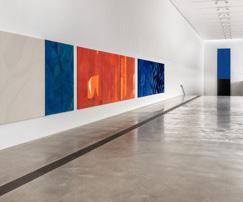
The Pulitzer’s second exhibition, “Urban Archeology: Lost Buildings of St. Louis” features a variety of salvaged architectural artifacts from the National Buildings Arts Center in Sauget, Illinois. “The National Building Arts Center was founded in the 1970s by a person named Larry Giles who started salvaging and taking pieces from buildings before they would be demolished. It is the largest collection of building artifacts in the country,” said Moog.
The exhibition’s diversity in pieces emphasizes the interplay between the built environment and narratives embedded within it. “I think one interesting thing about the show is that some of the buildings bring up more social histories, others more technical and artistic histories,” said Moog. The exhibition showcases a wide range of works, from bricks that tell stories about material innovation to lion heads emblematic of wealth.
The Cube Gallery displays pieces of the façade of the Rivoli Theatre, which stood in the Central Business District of Downtown St. Louis, before its demolition. The hand painted ‘Rivoli’ sign, sitting atop display pedestals, was dismantled from ornamental panels seated to the side in their original crate, a deliberate choice. “It’s a nod towards the way this object lives when it’s not in a building like this, and tries to get people to think about when you see an object like this in a museum, where does it come from? And, what is it like to experience something out of context?” said Moog.

In the 19th century, St. Louis became one of the largest brick and terracotta manufacturing areas in the world. The Fox Theatre, down the block from the Pulitzer, is one of many historic buildings that still showcases the craftsmanship of terracotta bricks. The exhibition’s collection of decorative, paver, and fire bricks showcase the history of brick production in St. Louis.
The east and west galleries display panel reliefs, pendants, and prominent neighborhood artifacts. Between the two galleries, an interactive space offers a sizable map of the surrounding area as well as note cards sparking reflection. “People can leave their personal associations with buildings and then mark them on the map,” said Moog.
“Sarah Crowner: Around Orange” and “Urban Archeology: Lost Buildings of St. Louis” will be on view through Feb 4, 2024 at the Pulitzer Arts Foundation.
“Blue Black” Ellsworth Kelly (Photo courtesy of Photography Virginia Harold © Pulitzer Arts Foundation)
(Photo courtesy of Photography Virginia Harold © Pulitzer Arts Foundation)
ARTS & LIFE Zach Bryan’s Vulnerable, Chill Inducing Self-Titled Album
BRENDAN BRUNETTE Senior Writer
Zach Bryan’s self-titled fourth studio album made history by securing his first number-one spot on the Billboard Top 200. Released on Aug. 25, 2023, the 16-track album has not only amassed over 200,000 album-equivalent units but has also earned critical acclaim for its raw, emotional storytelling, a consistent trend from the 27-year-old. Some are even comparing Bryan’s uprising in country music to that of Kurt Cobain and Nirvana, a grunge rock band that reinvented and redefined the Rock genre in the 1990s.

Fittingly, the album that bears Bryan’s name is entirely self-produced, with Warner and Belting Bronco Records serving as the label companies, respectively. With a runtime of 54 minutes and 23 seconds, each individual song tells a unique story and provides a lens into the artist’s mind through Bryan’s raspy, soulful voice. This remarkable element of Bryan’s music, which can be found in virtually every song he creates, is an uncommon trend amongst mainstream musicians today. The vulnerability and relatability of Bryan’s work has put the young artist on the map. “Zach Bryan” also features guest appearances by Kasey Musgraves, The War and Treaty, Sierra Ferrell and The Lumineers.
“I’ve got no grand explanation for these songs, I [have] got no riddle in reasoning behind writing them,” Bryan said in an Instagram post. “I just wrote some poems and songs that I want to share because I think they’re special. Some of them are heavy, some of them are hopeful, but more than anything what’s most important to me is that they’re all mine.”
The album immediately skyrocketed and has earned the largest streaming week for a Rock album in Billboard chart history.
Despite his newfound stardom, Bryan has come from humble beginnings. Born in Okinawa, Japan, while his parents were stationed in the Navy, the musician was raised in Oklahoma, received his first guitar at 14 and enlisted in the Navy at 17, using his free time to write songs. In 2017, an iPhone video of Bryan singing “Heading South” outside of his Navy Barracks went viral on YouTube, and the world saw the gripping, emotional weight that Bryan’s voice and music holds.
The raw and moving YouTube video has generated over 23 million views and 288 thousand likes to date. Bryan received an honorable discharge in 2021 after serving for eight years and went on to pursue music full time.
The groundbreaking musician has combined country, rock, folk and americana into one distinctive sound. Bryan’s debut album “DeAnn” came out in 2019 and was named after his late mother. Bryan’s third studio album and major label debut, “American Heartbreak,” was a major turning point for the singer, as it was the first time his music garnered national recognition. The album’s second track, “Something in the Orange,” instantly became the album’s most popular song and ultimately took the number-one spots on the Billboard U.S. Hot Country Songs and the U.S. Hot Rock & Alternative Songs. Despite his country roots, Bryan refuses to cater to modern-day country music stereotypes, unlike many of the major country artists of today, and helped push country music to mainstream media for the first time in 30 years.
Fans have already even compared Bryan’s impact on country to Nirvana, proclaiming that he has made country music cool again like Kurt Cobain did with rock in the ‘90s.
The most prominent leader of this notion is Grady Smith, a country music advocate who has written for major publications and has over 200-thousand subscribers on YouTube. In 2015, Smith wrote an article for “The Guardian” titled, “Country music is the new hair metal - and we need a Nirvana moment,” which discussed how country was facing an image problem, how it had become dominated by formulaic, bro-country party anthems, and how it needed a “Nirvana moment” to save the genre. However, on Sept. 6, 2023, Smith released a follow up video, “This is Country Music’s Nirvana Moment,” stating that Byran’s refusal to cater to modern country music stereotypes is almost identical to how grunge band Nirvana helped redefine Rock music in the 1990s.
“[Zach Bryan] is almost in the same position within country music that Nirvana was in Rock music 30 years ago,” Smith said. “Just like the [rock] industry had to figure out why Nirvana was popular and swallow their own pride, the country music industry is continuing to learn they’re going to need to reckon with this sound being the cool sound of country music in order to move forward and stay relevant,” he said. “I think it’s cool. We’re in the midst of a full-on country music revolution.”
Bryan’s North American “Quittin Time Tour” will begin in March 2024 and will go until December of that year. He will be stopping in St. Louis and playing at the Enterprise Center on May 3 and 4, 2024, with The Middle East and Levi Turner.
In a trailblazing moment for his career, Zach Bryan’s eponymous fourth studio album historically marked an important milestone in the resurgence of authentic storytelling within country music. Defined by its raw emotional depth, unique sound and refusal to conform to modern country stereotypes, Bryan’s music has sparked a revival reminiscent of Nirvana’s impact on rock in the ‘90s, positioning him as a leader in a country music revolution that continues to challenge the status quo.
(Warner Records / The University News)
09
Body of Work
RF HM DZ HN XS CR ZJ OP IK
EL CS UM ST OM AC HV HW AH
VB Y AEP ZM WY RL CERS CQ
IQ TE NV NN TZTT DI DK EL
LW JR NO RI BS IX BN KI LU
XP YC TD TE DQ LY AS FN LN
LQ BNEU IE NR AL WS PI SG

IU EA MB WK LW GT ON SI LS
G BVP YD OM OE EI TO BO NS
AA LK NE EL PSK RHD SY WE
MR AO GW SP Y SAS XN CA MN
ET PX OL OA QC TBZE ZC LO
NE PNVD PX HQ WN WT XB TB
TR EY BU HE ZB RA IN MR ST
LY NR JQ AN WH AT ZO AEHZ
IN DA EI GR LK AU PE JV XI
BR IL SK US MM ZI HK SF JI
GO XW IA SL KO HQ RM UJ XT
APPENDIX ARTERY BLOOD BONES BRAIN
CARTILAGE CELLS
RIBS
SKELETON SKIN SPINE SPLEEN
STOMACH
TENDONS
TONSILS
TRACHEA
VEINS
games Find the solutions to this issue’s puzzles on unewsonline.com Copyright ©2023 PuzzleJunction.com University News 9/27/23 Crossword PuzzleJunction.com 36 Flipper 38 Gobbled up 40 Yard tool 45 Not liquids 48 Lt.’s inferior 50 Bargain 52 Avarice 53 Diminish 54 Rapids transit 55 Declares 56 Royal pains 57 Nocturnal insect 58 Mozart’s “Il mio tesoro,” e.g. 60 Writer Ferber 63 “___ you sure?” 64 Friend of Frodo 66 Belief system 1234 567 89101112 13 14 15 16 17 18 19 20 21 22 23 24 252627 28 29 30 313233 343536 37 38 39 40 41 42 43 44 45 46 47 48 4950 51 5253 545556 5758 5960 61 62 6364 65 66 67 68 69 70 71 72 Across 1 Dear, as a signorina 5 Petition 8 Medication amounts 13 Dazzles 14 It’s south of Georgia 15 Methuselah’s father 16 Texas geographic region 18 Coconut meat 19 Before, of yore 20 Boxer’s need 22 Run smoothly 23 Put in stitches 24 Medal recipient 25 Proof word 28 Double-crosser 29 Rap session? 31 Military installation 34 Resting place 37 Mediterranean island 39 Fragrant oil 41 Bag thickness 42 Exertion 43 Bellini opera 44 Hill dwellers 46 To be, in old Rome 47 More submissive 49 Quirky 51 Paradise lost 52 Battering wind 54 Bottle topper 57 Yoga class need 59 Kosovo locale 61 Caesar’s hello 62 Killer whales 65 Reporters’ aims 67 Coronet 68 Hair controllers 69 Variety 70 Sheik’s bevy 71 Stock follower 72 Clutter Down 1 Mantles 2 Savvy 3 Extend, in a way 4 Shade of blond 5 Passion 6 Artillery burst 7 Kind of socks 8 Holiday mo. 9 Lennon’s love 10 Ancient Greek dramatist 11 Beige 12 Pretense 14 Coastal features 17 Eastern pooh-bah 21 “Get the picture?” 26 Butts 27 Chewed, beaver style 28 Hollowed out 29 Seasoned sailor 30 J.F.K. postings 31 Prohibit 32 Proton’s place 33 Trolley 35 Actor Epps University News 9/27/23 Word Search PuzzleJunction.com
Copyright ©2016 PuzzleJunction.com
MUSCLE NERVES PANCREAS University News 9/27/23 Sudoku PuzzleJunction.com Copyright ©2023 PuzzleJunction.com To solve the Sudoku puzzle, each row, column and box must contain the numbers 1 to 9. 16 5 7 62 89 4 9 6 8 1 5 13 2 9 5 87 3 54 8
ESOPHAGUS GLANDS HAIR HEART JOINTS KIDNEY LARYNX LIGAMENT LIVER LUNGS
PHOTO 11
Forest
Park Balloon Glow
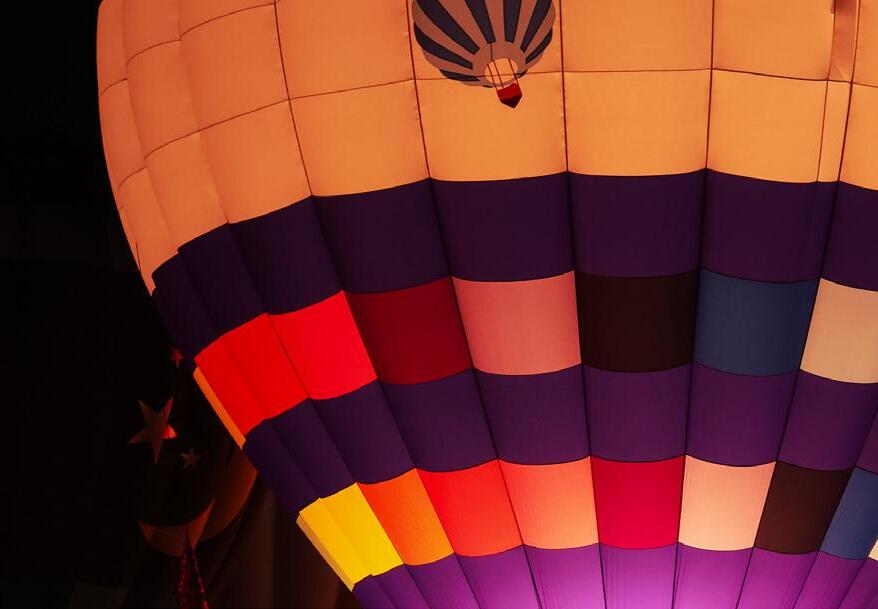






 (Photo courtesy of Nadia Abusoud)
(Photo courtesy of Nadia Abusoud)
(Photo courtesy of Nadia Abusoud)
(Photo courtesy of Nadia Abusoud)
(Photo courtesy of Nadia Abusoud)
(Photo courtesy of Nadia Abusoud)
(Photo courtesy of Nadia Abusoud)
(Photo courtesy of Nadia Abusoud)
(Photo courtesy of Nadia Abusoud)
(Photo courtesy of Nadia Abusoud)
PHOTO 12
SHOP LOCAL

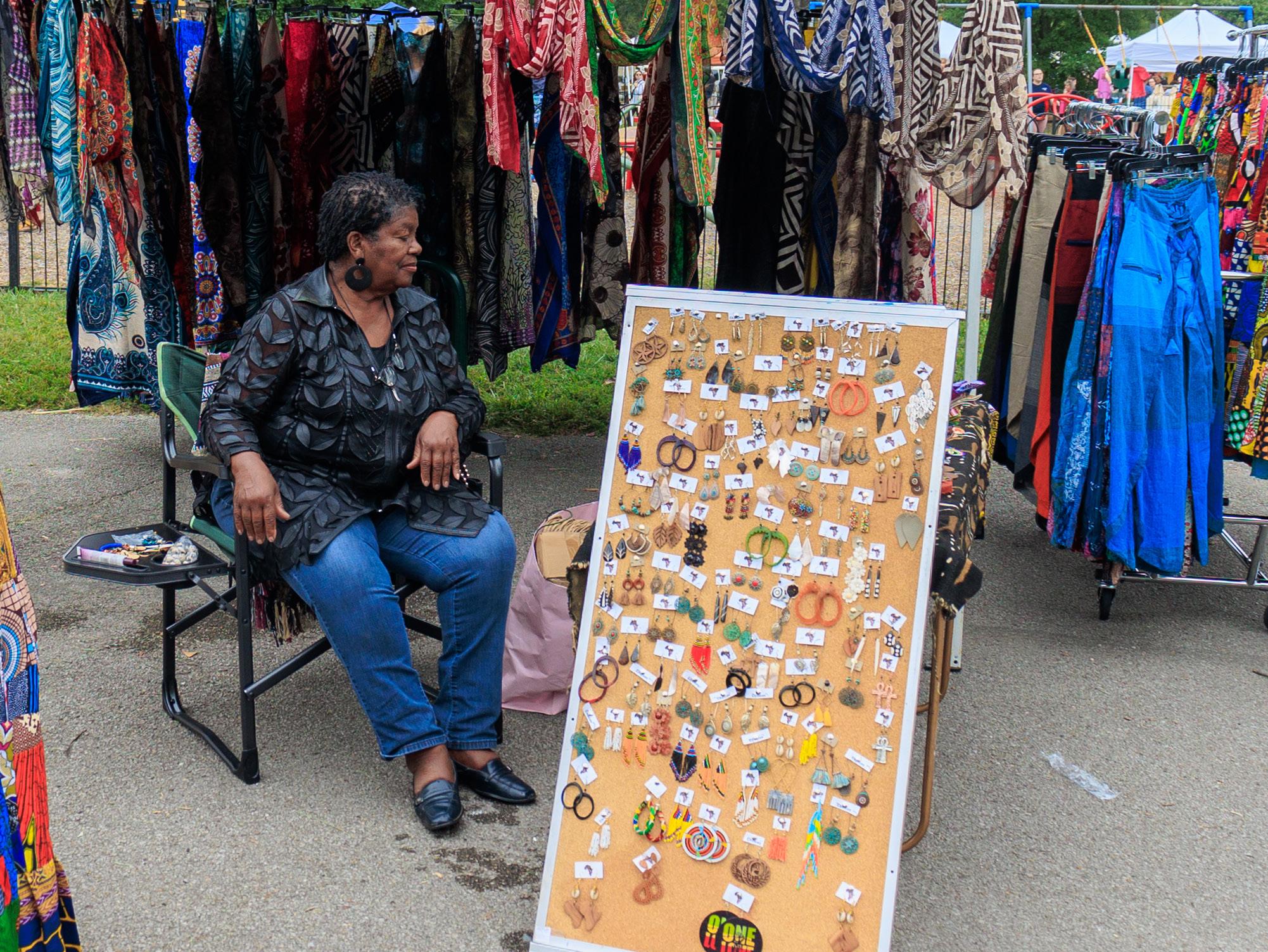

TOWER GROVE FARMER’S MARKET





The Tower Grove Farmer’s Market is a hub for local vendors within Saint Louis and surrounding areas. This local market launched in 2006 and has grown each year. Since 2006, the Tower Grove Farmer’s Market has expanded to areas outside of Tower Grove. There is the traditional Saturday market in Tower Grove, the Boulevard Market on Sundays in Richmond Heights, the Rockwell Beer Garden Market in Francis Park, and the Tuesday Market in Tower Grove. The market hosts 130 vendors weekly. These vendors range from fresh produce, baked goods, merchandise, art, and live music. There truly is something for everyone at the Tower Grove Farmer’s Market

13
Emma Duman Photography Editor
PHOTO
PHOTO
Black Student Alliance Bridgerton Tea Party

SLU’s Black Student Alliance threw a Bridgerton themed brunch on September 17. Guests dressed in semi formal attire and enjoyed a Regency Era inspired afternoon tea in the Sinquefield Room in DuBourg Hall.


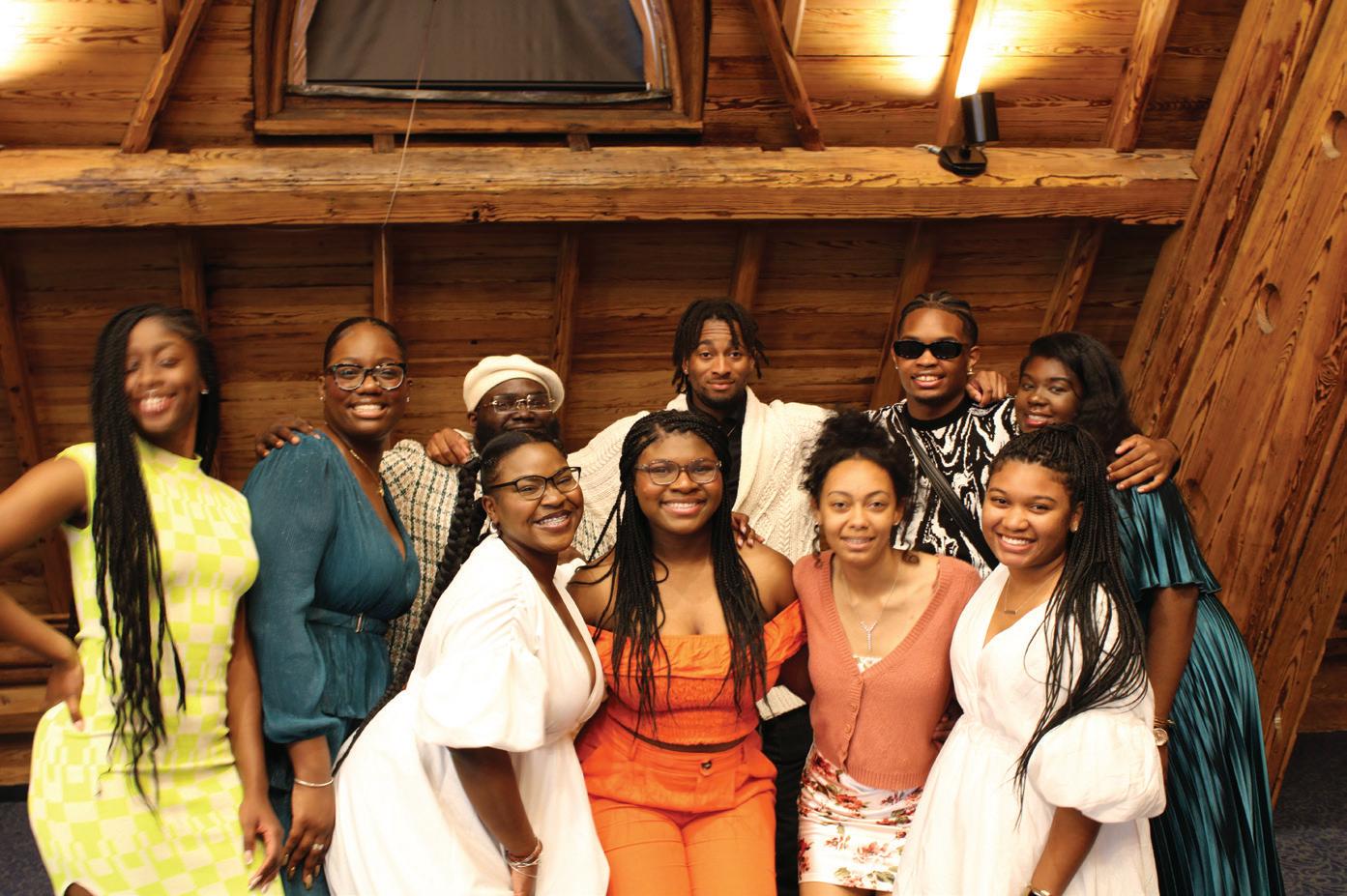
14
(Abby Campbell / The University News)
(Abby Campbell / The University News)
(Abby Campbell / The University News)
(AbbyCampell / Te UniversityNews)
Sports
The Buffs are Back and Better Than Ever
Coach Deion Sanders, of the University of Colorado, Boulder (CU Boulder), is transforming the Buffaloes football program, while concurrently making collegiate football history. Deion Sanders, commonly known as Coach Prime, is in his first year coaching at CU Boulder and is making a huge statement in the world of college football.

Former MLB and NFL superstar Deion Sanders is new to coaching, but not new to the world of sports. Prime won two Superbowl titles and made a World Series appearance in 1992 during his time playing, making him the only athlete to play in both a Super Bowl and a World Series. Long after his initial retirement, Coach Sanders could not stay away from sports and made his return to the world of pro sports as a coach.
Prime began his coaching career in 2020 at Jackson State University (JSU). JSU is an HBCU not particularly known for its football program. Prime’s intense and motivational coaching style allowed JSU’s record to improve from 4-8 to 12-1 after just 2 years. After great success at JSU, Prime was hired as the new head coach of the Colorado Buffaloes.
The Buffaloes had a disappointing season in 2022, winning a singular game. Following their 2022 season, it was evident that the Buffaloes needed a change in leadership. When Sanders was hired as the Buffaloes’ head coach in December 2022, he was eager to turn the Buff’s program around. Sanders did all in his power to transform the Buffaloes team, making a more competitive roster. Sanders took advantage of college football’s now unrestrictive transfer rules to stack his roster with well-faceted players.
While CU Boulder’s season is still young, they have had a phenomenal start. The Buffaloes came out with a bang with a 45-42 win against Texas Christian University (TCU). The TCU Horned Frogs were just one game away from winning the national title last year. The Buffs did not stop there; they followed up a week later with a dominant 36-14 win over Nebraska.
In their most recent game, the Buffaloes experienced their first loss of the season to the Oregon Ducks, ranked ninth, 6-42. In a postgame interview, Coach Deion Sanders gives credit to the Oregon Ducks, saying, “That was a really good, old fashioned, butt-kicking.” Oregon dominated the game from start to finish. Colorado had a hard time executing plays, making it hard for them to stay competitive in the game.
Sanders acknowledged where his team can improve going forward, “We expect to win every game… and go out there and execute the things we practice… we just didn’t do it today.”
A dedicated Buffs fan says Coach Deion Sanders “brings energy and passion back to CU football.” In speaking about this story’s significance, Buffs fans continue to stay positive about the long season ahead, “I see a season full of triumphs ahead.”
Coach Prime’s use of the portal will set a precedent for coaches trying to transform teams in the future. Sanders has been a winner his whole life and does not plan to stop now. The Buffaloes’ next matchup is on Saturday, Sept. 30 versus the University of Southern California, Trojans at home.
(Photo Courtesy of CBS News)
NORA KOTNIK Sports Editor
15
Sports 16
Women’s Soccer Begins Conference Play

Record Improves to 7-2-2
The Billikens began conference play on the Sept. 14 with a 1-0 win against the Loyola Ramblers. SLU’s goal came courtesy of defensive superstar Lyndsey Heckel, a header off of a perfectly placed corner kick by junior midfielder Hannah Larson. That Sunday the Billikens would host the LaSalle Explorers to kick off SLU’s homecoming week.
LaSalle came to St. Louis 3-5-2 and had yet to begin conference play. The Billikens gave them a harsh introduction, beating them 4-0. The game started slow, with both teams only putting forward five shots in the first half, entering the second tied at 0-0. Momentum would shift less than five minutes into the half when SLU forward Emily Gaebe got fouled in the box by Explorer junior midfielder Gabby Picco. Heckel would net her third goal of the season by skipping it into the lower left corner, clear of LaSalle’s junior keeper Michela Auguadro. Twenty minutes later freshman defender Eva Schreiber would collect a loose ball and make a run along the left touchline before crossing it to Gaebe who would pad the lead with a touch, placing it just out of Auguadro’s reach and into the back of the net. LaSalle would not have much time to breathe as two minutes later, in the 71st minute, Hannah Sawyer would recover her own corner kick that had been punched away and bounce it into the goal off of the far side post.
Freshman forward Jordan Gary earned the assist with a pinpoint accurate volley pass to Sawyer who dribbled past LaSalle’s Emily Banashefski and sailed it over Auguadro to give the Billikens a 3-0 lead with just under nineteen minutes left to play.
Emily Gaebe drove in the final nail of LaSalle’s coffin in the 74th minute. Seizing an opportunity Gaebe intercepted a pass by defender Jillian Drumm intended for Courtney Gaston and ran head-on towards Auguadro. Outrunning Picco, she skimmed it past Augruadro into the lower right to score her second goal of the match and her fifth of the season. SLU improved to a 7-2-1 record off of an overwhelming offensive performance. SLU out-shot LaSalle 15-8 and tripled their shots on goal 9-3. Saint Louis currently leads the Atlantic 10 in shots per game with 17.3, ahead of University of Dayton’s 15.67.
On the topic of Dayton, the Flyers came to Midtown on the Sept. 24, one week after SLU’s victory over LaSalle. Dayton would tie SLU 1-1 in a hard-fought match. Dayton’s defense is among the few in the A-10 capable of keeping up with SLU’s fast-paced, aggressive offense. They also have an elite defense, anchored by sophomore goalie Batoul Reda who has the second fewest goals allowed in the conference, with eight, only behind Massachusetts’ Bella Mendoza, with seven. SLU’s Emily Puricelli isn’t far behind with ten. Puricelli
is fourth in the conference in saves per game, stopping 55 shots in eleven games played. Puricelli and Reda both had six saves during Sunday’s game, only one getting by each. SLU had chances to score in the first half, including a header by Stramm off of the near post and a screamer by Sawyer that was just high, but instead finished the half tied 0-0.
SLU’s goal came in the 52nd minute when freshman midfielder Emma Blockius would head it out of the backfield over the midline to Gaebe who would turn and burn to get by three Dayton defenders and launch it into the back of the net. Blockius’s assist was her first-ever point as a Billiken. Dayton would equalize in the 70th minute when senior midfielder Diana Benigno pivoted into a shot, placing the ball just past Puricelli and into the bottom left of the goal. Gaebe would have a chance to put the Bills back on top in the 87th minute with possession a yard away from the goal but wouldn’t be able to get the shot off under the pressure of multiple defenders. Both teams would come away disappointed with the result as each considers themselves a contender for the conference title.
With seven games remaining in the regular season, all conference matchups, Head Coach Katie Shields is likely to continue to make adjustments to maintain the Billikens’ five-season streak of A-10 Championship titles.
ISMAEL DOMIN Sports Editor
(Emma Duman/The University News)
Softball Begins Preseason With Dominant Wins
 ISMAEL DOMIN Sports Editor
ISMAEL DOMIN Sports Editor
On Sept. 16 the Billikens Softball team began their fall season with back to back wins against Washington University (WashU) in St Louis and John A. Logan College. The Billikens won the Atlantic 10 softball regular season last spring, but fell short of the championship in a 5-7 extra innings loss to Loyola Chicago. Looking to regain their energy from last season and evaluate their roster, Saint Louis University hosted a trio of games, playing in the first two, winning 8-2 against WashU and 8-0 against JALC.
SLU played WashU first. The two hour long onslaught began in the bottom of the third inning when junior outfielder, Natalie Sullivan, drove one into the outfield for a base hit and SLU’s first score of the day. WashU would tie shortly thereafter with an RBI of their own, coming off of a double driven up center field. The Bears would take the lead by taking home on a wild pitch. SLU would tie when the Bears threw a wild pitch of their own, allowing freshman pinch runner, Karsen Jany, to cross home plate. The Billikens would take back the lead thanks to freshman pitcher, Anna Christ, who would slam it deep into left field for a double and bring a runner home. Sophomore, Ashley Marietta, would end the inning with a grounder along the first base line to advance the runner at third. In the bottom of the fifth, Sullivan would bunt to load the bases. Sophomore power hitter, Chloe Rhine, would be walked, advancing Kendall Johnson to home and keeping the bases loaded. Sophomore catcher, Abby Mallo, would hit a double for two RBIs and shortly after crossing the plate herself, Johnson would bring the Bills’ total to eight with a grounder before the inning’s end. Due to time constraints the game would end an inning early, SLU forfeiting and nine phantom runs being added to WashU’s score so that SLU could play John A. Logan at the scheduled time.
The Volunteers were no match for Saint Louis as they would only put forth two hits against the Billikens’ 12. The first point of the game would be scored early in the second inning by fifth year lefty, Cami Newbanks, who would slam a homer well past the fence for the 1-0 lead. Soon after, freshman infielder, Abby Ulsas, would walk to load the bases. With bases loaded Sullivan would take ball four to bring Ashley Marietta home. In the fourth inning, SLU’s second home run came off the bat of Mallo, who would take Ulsas with her to home plate, bringing the score to 4-0. After going scoreless in the fifth, the Billikens would add to their already impressive total with a line drive by Abby Ross for an RBI. Graduate catcher, Kelsey Etling, would hit SLU’s third home run of the afternoon with runners on first and second to bring the score up to eight. It wasn’t until after these four runs did the Volunteers finally secure an out. The Billikens would hold the volunteers to a single hit in the final inning, bringing their total to two and keeping them scoreless for a 8-0 victory.
WashU and John A. Logan are not the same caliber of opposition as SLU’s conference opponents, but these preseason games give confidence to the team and its fans that the Billikens can win the Atlantic 10 regular season again, as well as the tournament championship they lost out on last year. Young sluggers, Mallo and Rhine, were second and third on the team in slugging percentage last season as well as being in the top four in
runs, home runs, RBIs and total bases and will likely improve. Mallo and Rhine were among the A-10’s best hitters last season during their freshman year and head coach Christy Connoyer and her staff will only help them to improve. Natalie Sullivan and Jane Kaniecki are two elite hitters whose veteran presences can’t be ignored either. With the offense proven the only questions reside on the other end of the ball. Chloe Wendling was arguably the A-10’s best pitcher last season and concluded her collegiate career as one of the best pitchers in SLU history. Her usual closer Kaili Hanner also graduated last spring, leaving the door open for tertiary pitcher Taylor Hochman as well as freshmen Isabel Royle, Lily Strand and Anna Christ. The decision rests with Connoyer and these preseason games will impact her decision greatly.
17
(Photo Courtesy of SLU Athletics)
sports
sports
Pro Women’s Hockey League to Debut in January
EMMA BROWKA Staff Writer
The night of Sept. 18 marked a major milestone for women in sports, more specifically, in the world of women’s hockey. The newly founded Professional Women’s Hockey League held its first draft in Toronto, where 90 of the best female ice hockey players from eight different countries were selected to play in the six-team league. Cities that will host teams include: Toronto, Ottawa, Montreal, Boston, Minneapolis-St. Paul and New York.
The first pick of the draft was announced by Billie Jean King, tennis star and well-known advocate in women’s sports. Minneapolis-St. Paul selected Taylor Heise, a Minnesota native whose accomplishments prove that she has earned her spot in the league. Heise recently finished her career at the University of Minnesota, where she led the NCAA with 30 goals in her final season. Heise also took home a gold medal with Team USA
at the Women’s World Hockey Championships this past April.
The creation of this league has been long awaited by both the players and fans, as previous professional leagues have been quick to dwindle out. Never has there been a women’s hockey league with the aim of highlighting the best players from not only one nation, but from an international field. This opens the opportunity of greater competition to players from other countries besides the widely dominant United States and Canada, whose teams have taken home every Olympic and World Championship in the past. Women in the sport will now have the choice of which path they wish to take: being with a professional team, with a national team or being with both.
The PWHL also brings the option of fulltime employment to these female athletes. Hillary

Knight, American forward and founding board member of the Professional Women’s Hockey Players Association, negotiated on behalf of the female athletes entering the league. Housing stipends will be provided to players in their respective cities of play, as well as an average salary of $55,000 for players league wide.
Final team rosters will hold 23 players per team, with 24 regular season games to be scheduled for each. Training camps are set to begin in November, followed by the season debut in January. The first season of the Professional Women’s Hockey League is sure to make history in women’s sports, as well as inspire the next generation of players to follow in the footsteps of the trailblazers that have made this league a reality.
18
(Photo Courtesy of NBC Sports)

19
opinion
The Influence of Polarization Every Action comes with a Reaction
 CALLA TRUSCHEL JACOBS Staff Writer
CALLA TRUSCHEL JACOBS Staff Writer
Over the past year, the hashtag “cleangirl” has gained traction within media platforms like TikTok, Pinterest and Instagram. The term is associated with individuals, primarily women, who have clear skin, well-coordinated outfits and minimalist makeup. The idolization of this polished appearance has led to a counterreaction from those who grew tired of this highly structured “clean” lifestyle. In recent months, a new trend has emerged in response to the clean girl aesthetic: the hashtag “messygirl”. The messy girl aesthetic embraces the idea of falling asleep with makeup on, bedhead, overindulgence in fast food and substance abuse. This surge in popularity of the messygirl movement highlights the dangerous and polarizing nature of social media trends, where to reject them is to risk feeling isolated from your peers, but to accept them is to risk your health.
Upon initially encountering the cleangirl aesthetic on TikTok, I was captivated. My feed was filled with videos featuring tan, blonde, women sipping green juice, attending early morning pilates classes, meticulously styling their hair and applying subtle makeup for a no-makeup look. The idealization of a flawless, put-together appearance attracted me, and I made earnest attempts to replicate the qualities promoted by the “cleangirl” trend. I purchased products from brands that promised consumers that if they bought their overpriced makeup, they would be “clean.” I did pilates classes and dressed in neutral colors, rejecting all of the color that I owned. I also adhered to a relatively healthy diet, as much as my sweet tooth would allow, all in an effort to embody the cleangirl aesthetic endorsed by social media.
However, my fixation on perfection and orderliness took a turn with the introduction of the messygirl trend. The messygirl aesthetic emerged as the antithesis to the perfection propagated by the #cleangirl trend. It represented the rebellious younger sibling of the clean girl, featuring images of underfed models smoking
cigarettes in the back of taxis, presumably on their way to parties where they would participate in destructive activities. As a conscientious consumer, I, too, felt compelled to conform. I agreed that the clean girl aesthetic had become tiresome and embraced the chaos and disarray of the #messygirl aesthetic. Rather than aspiring to sleek hair, I looked forward to my unbrushed morning waves. Instead of attending pilates classes and going on “hot girl walks,” I relished lounging in bed all day, drifting in and out of sleep. My wardrobe shifted from tight-fitting athleisure to baggy shorts and quirky slogan tees (my favorite that I purchased in this era being the “F*ck You You F*cking F*ck” tee). Overall, every action and purchase I made in the past four months signaled a complete rejection of the aesthetic I had previously idolized.
To understand why both the clean and messy girl trend emerged, it is essential to delve into their histories. While the term “cleangirl” only recently gained popularity in 2022, its roots date back several decades. The concept of subtle makeup, slicked-back hair, and bold eyebrows originated in the 1980s, thanks to black and Latinx women. However, it only garnered widespread recognition when thin, clear-skinned white women began to embrace the look, receiving validation on platforms such as TikTok. A search for clean girl aesthetics on Pinterest shows that it takes effort to find a person of color representing the trend, despite their contributions to its creation.
In contrast, the messygirl aesthetic has problematic origins of its own. The aesthetic can first be traced back to the late 1990s and early 2000s, a period characterized by the celebration of “heroin chic.” This trend glorified models like Kate Moss, Naomi Campbell and Shalom Harlow while promoting dangerous weight loss practices. The messygirl trend also romanticized a lifestyle devoid of purpose beyond heavy substance abuse and partying. This trend, which first appeared in the early 2000s, is now experiencing a resurgence with the idolization of models like Bella Hadid, who has faced extreme controversy surrounding rumors of her use of cocaine for weight loss.
Both the cleangirl and its reactionary counterpart, the messygirl, represents unhealthy extremes. The media’s propensity to inundate consumers with these unbalanced lifestyles can push young girls toward perilous extremes in the pursuit of beauty. While the clean girl aesthetic promotes a relatively healthy lifestyle that includes skincare, sleep, exercise and a balanced diet, it suggests that anyone who does not fit this ideal is “dirty.” This not only fosters a class divide when defining beauty but it also shames those who have hyperpigmentation or acne, by implying they are in some way “dirty”. Or “unclean” if they enjoy a sweet treat or something made of carbohydrates. Additionally, the clean girl trend incorrectly credits its creation to white, wealthy women, erasing the contributions of black and Latinx women.
On the other hand, the messygirl trend gained popularity because it presented a stark departure from the structure of the clean girl. While the messy girl can highlight the importance of living life to the fullest, it may inadvertently encourage young individuals to engage in addictive and dangerous substance use, all in pursuit of an aesthetic.
When engaging with media trends, it is crucial to recognize that media thrives on the polarization of specific lifestyles. While consuming such content can provide aspirational goals and a rush of dopamine, it is important to acknowledge the dangers of idolizing trends. Maintaining a balanced lifestyle, regardless of what trends promote, is essential for personal well-being.
The rise of the clean girl and messy girl underscores the polarizing nature of media trends. These extremes can place undue pressure on young, impressionable girls to conform to unhealthy ideals. Acknowledging the potential consequences of these trends is a critical step in maintaining a healthy perspective on beauty and lifestyle choices.

20
opinion
Homecoming Carnival Cancelled After Ferris Wheel Rolls Away: It’s Gone!
This weekend SLU hosted its annual family weekend and homecoming. Hundreds of excited participants flocked to the festivities including community dinners, open houses and sporting events. However, the most anticipated event was the pop-up amusement park inside of the Marchetti parking lot.
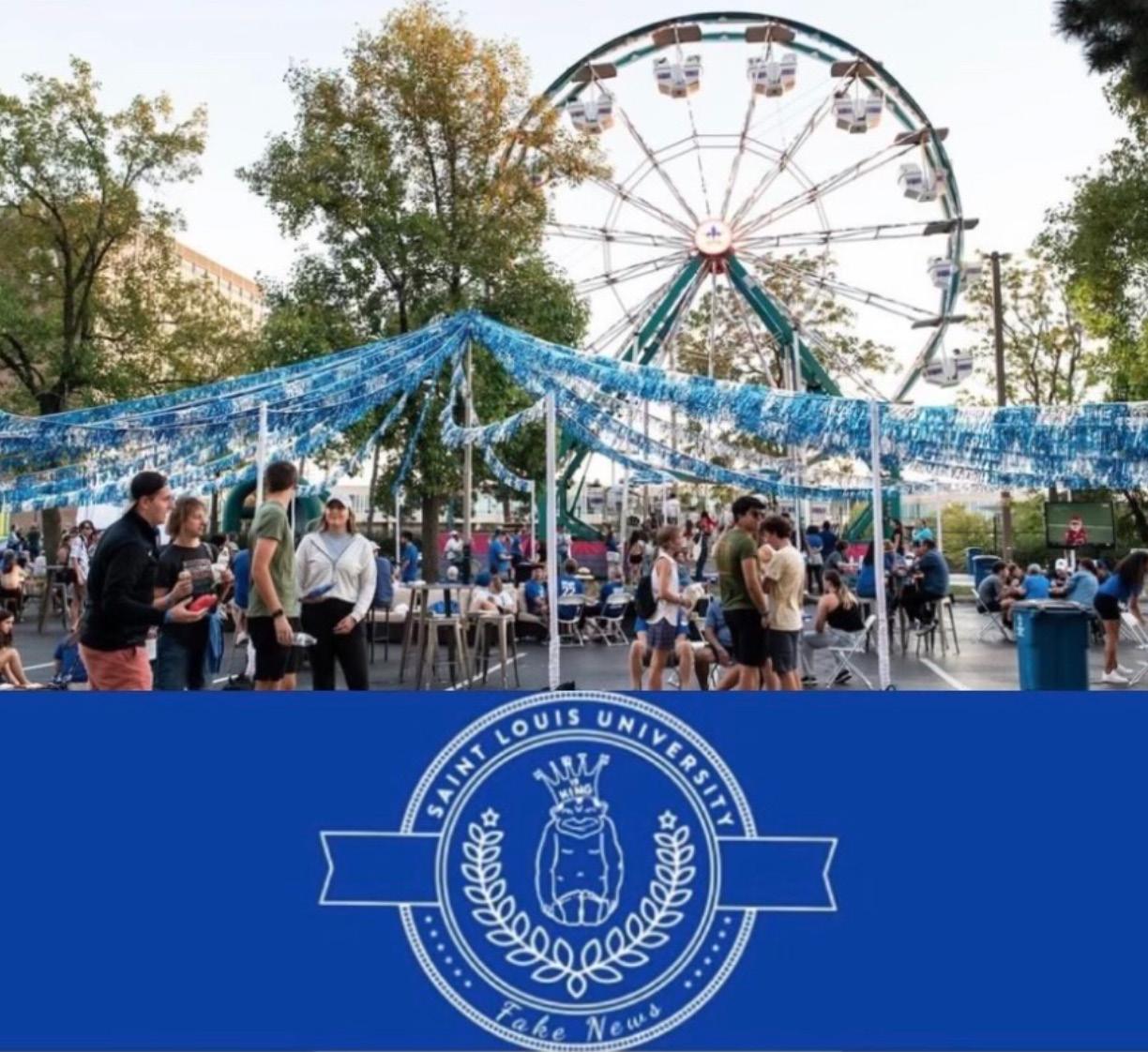
In exchange for their parking spaces, Marchetti residents got to experience the rides and fair atmosphere up close and personal. Additionally, they were given “fun passes” which allowed them priority access to the rides outside of typical operating hours without supervision. Yet, the Marchetti residents may have gotten more than they bargained for this year.
As the fair was winding down late Saturday night and the rides were letting their final passengers off, loud mechanical grinding sounds could be heard coming from the Ferris wheel at the heart of the carnival.
Without warning, large bolts tumbled into the crowd gathering around the ride. The wheel had broken loose of its bindings, and seemingly with a mind with its own, began to roll East towards the Arch. DPS was called to the scene and promptly issued a SLU alert, but the wheel could not be stopped. It was too late as the carnival ride picked up considerable speed as it raced downtown.
Witness reports state that it sped under the Arch and launched into the mighty Mississippi, sinking to its watery grave. Luckily, no one was injured in this harrowing event. Regardless, university officials canceled any further fair events for the remainder of the weekend due to suspicion of the other rides. Disappointed families were redirected to other, less fun, homecoming events.
(Photo Credit slufakenews)
SATIRE 21
For more satirical news articles, such as this one, follow @slufakenews on Instagram.
opinion
Which Side Are You On?
JOHNNY PRUSAK Opinion Editor
against the strike. The notion that the Ford Motor Company had its hands tied and could not continue to pay those 600 workers, or for that matter settle their dispute with the UAW is laughable. Ford knows exactly what they are doing by taking this course of action and sees laying off employees as a more cost effective and devious way to malign the UAW.
Pitting workers against each other is a key tactic of anti-union campaigns. The narrative goes that unions threaten non-union jobs as a strike in one sector of the economy will ripple and affect others. This reasoning fails to account for the fact that authorizing a strike is a means of last resort. The employers have all the power to come to the negotiating table and settle on a contract, however
Unions gave you the weekend. Unions gave you 8 hour work days. Unions gave you child labor laws. The reason behind every instance of labor rights can be traced back to unions or union agitation. Now, Americans have a higher approval rating for unionization than ever before.
These sentiments come at a decisive time. Labor activity is rising around the country at unprecedented rates. On May 2, writers belonging to the Writers Guild of America (WGA) took to the picket lines in order to halt executives from replacing their labor with AI. Additionally, writers asked for higher wages, especially in the form of residuals, as many of the profits from streaming services are collected that way.
In more recent news, the United Auto Workers (UAW) has authorized a strike at three plants belonging to Ford, General Motors and Stellantis. One of the GM factories is located just west of St. Louis in Wentzville where nearly 4100 workers have taken action by demanding a 36% pay increase and 32 hours of work for 40 hours of pay. Many of their families are struggling coming off the pandemic and with inflationion rising faster than wage increases, they are simply asking for their already negotiated raise.
While workers will win the war for their rights, many battles will test the integrity of organized labor. Ford is already stoking these fires by laying off 600 non-UAW employees in Michigan as retaliation
since profits will be negatively impacted, that option cannot be explored.
If a hardware store were to unionize and demand better working conditions, then in order to remain competitive, the other hardware stores must improve their conditions too. This also bolsters the economy as the average person’s purchasing power increases, thus allowing for more goods to be sold. A unionized workplace positively affects other industries surrounding it and the economy as a whole.
At this pivotal moment in time, unions need support now more than ever. Hollywood producers are starting to feel the pinch and are attempting to subvert the WGA and SAG-AFTRA. Recently, actress Drew Barrymore came under fire for announcing that she was resuming her television series despite the strike still continuing. Only a sustained campaign of public outrage caused her to back down. Refusing to purchase goods from companies with striking workers furthers class solidarity as companies will not find it profitable to hire scabs. In addition to creating awareness, donating to strike funds will help workers by allowing them to prolong their strike and put more pressure on the company. Lastly, joining the picket line and providing food and water can aid strikers by shifting resources to other uses.
You have a vested interest in the success of unionization across multiple industries. The better conditions they advocate for will spread to other companies in order for them to remain competitive. The employer can become a dictator of the workplace and unions seek to level the playing field. Many in popular media circles will report negatively on the UAW, WGA and SAG-AFTRA strikes as it is their prerogative to limit class consciousness. Solidarity requires sacrifice, and while that may be hard at times, sometimes these choices must be made. Organized labor will create a better world; it just needs some support.
Do not be a scab. Do not cross the picket line. Do not mourn; organize.

(Rachel
Zilligen / The University News)
22
“Unions scare corporations. Not only do unions work to secure rights in their own workplace, but will also have ripple effects in other industries.”
This Drink will Turn You into an Academic Weapon
How One Lemonade is Pushing the Boundaries of Alertness
KALEB YU Contributor
Recently, Panera released a brand new addition to their lineup of Charged Lemonades: The Blood Orange Splash. Upon first impressions, the orange liquid in the cup appeared like it was glowing. The taste was strangely familiar, similar to that of cough syrup and tang. A tall cup of this glowing concoction boasts over 360 milligrams of caffeine, which is about three RedBulls TM, along with no added sugar. It had been months since I last ordered one of these charged lemonades, and once I tasted The Blood Orange Splash, I was immediately reminded of the origins of my abstainment..

College is stressful and often there is not enough time in the day for sleep. Students are always hunting for ways to cram more information, pull all-nighters and sharpen their minds to tackle complex academic challenges. Enter the Charged Lemonade. With its intimidating caffeine content and monthly subscription service, it promises not just wakefulness, but an almost superhuman alertness that could make anyone feel like they just unlocked the academic version of a superpower.
In the fall of 2022, I was intrigued by the colors and advertisements for this product and shortly subscribed. Upon my first sip I was hooked. It was like the world became brighter and the air tasted sweeter. I had a lot more in the middle of the day and I found that other people were always walking excruciatingly slow. At the time I was taking 18 credit hours and enrolled in a notoriously difficult algorithms course. These caffeinated drinks allowed me to borrow tomorrow’s time and use it immediately. I had finally found the time it took to study and do well.
Then I flew too close to the bright yellow, artificially colored sun. I intended to maximize my subscription so I would drink up around two to three of these drinks per day. My grades began to race, along with my heart. I found myself jittery and anxious all the time. I built up a tolerance and required more caffeine to feel its promising effects. One day I looked up the nutrition content, when I saw the 390 milligrams of caffeine and up to 80 grams of sugar per drink, and I learned the true cost of these drinks was not $12.99 per month. I quit that day and stayed away until the release of the Blood Orange.
As tempting as it may be to rely on high-caffeine drinks for an academic edge, overindulgence can lead to adverse health effects. As with all things
that seem too good to be true, moderation is key. I will still enjoy one of these every now and then, but not at the rate as before. While their popularity is rising, it is important for everyone to be mindful of their caffeine consumption and listen to their bodies. After all true academic prowess is a combination of hard work, rest and maybe just a little sip.
University News) 23
(Siri Chevru / The
opinion
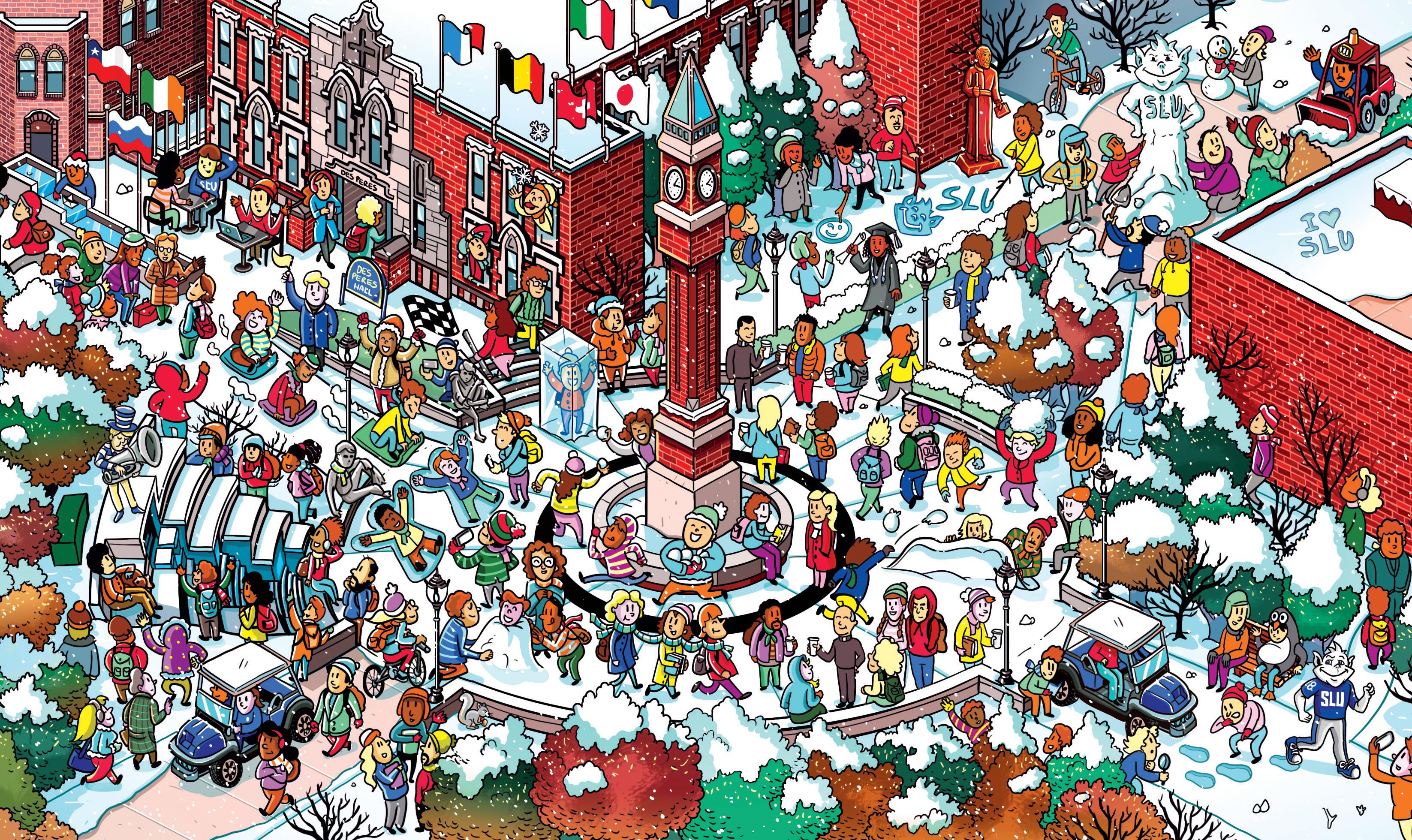
REGISTRATION CLOSES FRIDAY, DECEMBER 8
SPY A WINTER SESSION
SLU slu.edu/winter
I
AT



















 (Photo courtesy of Nadia Abusoud)
(Photo courtesy of Nadia Abusoud)
(Photo courtesy of Nadia Abusoud)
(Photo courtesy of Nadia Abusoud)
(Photo courtesy of Nadia Abusoud)
(Photo courtesy of Nadia Abusoud)
(Photo courtesy of Nadia Abusoud)
(Photo courtesy of Nadia Abusoud)
(Photo courtesy of Nadia Abusoud)
(Photo courtesy of Nadia Abusoud)















 ISMAEL DOMIN Sports Editor
ISMAEL DOMIN Sports Editor


 CALLA TRUSCHEL JACOBS Staff Writer
CALLA TRUSCHEL JACOBS Staff Writer




